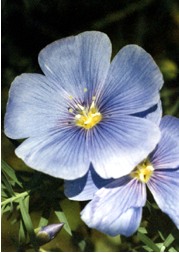(Linum usitatissimum L.)
Common flax is a species belonging to the Linaceae family. Its natural habitat is the Middle East, but it is currently not found in a wild state. Flax has been cultivated for over 7 thousand years for fiber used to make strong and fine yarn. Flax was already known in Ancient Egypt and Mesopotamia as a useful plant. In the 8th century in France, Charles I the Great established a law that required eating flax seed to maintain health.
Flax seed is harvested when fully mature is a raw material rich in mucus and polysaccharides. Oil, which is a valuable source of unsaturated fatty acids, is extracted by cold pressing.
Flax seed in the form of macerate is used as a means of promoting regular bowel movement and contributing to proper digestion. The content of polysaccharides, which cover the gastrointestinal mucosa, can be used to aid the natural function of the stomach.
P. Ody, Wielki zielnik medyczny, Wyd. Debit, p. 75
H. Strzelecka, J. Kowalski, Encyklopedia Zielarstwa i Ziołolecznictwa, Wydawnictwo Naukowe PWN, Warszawa 2000, p. 289-290
